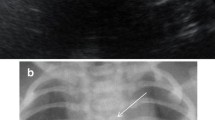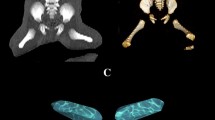Abstract
Purpose
To describe the temporal pattern of the appearance of the S1–Co1 centrum ossification centers (COCs) and provide reference data for the S1–S5 COCs and sacral length at various gestational ages (GAs).
Methods
Postmortem magnetic resonance imaging (MRI) was performed on 71 fetuses (GA, 17–42 weeks) using the 3D dual-echo steady-state with water excitation T2 sequence in the sagittal plane. To confirm the reliability of this sequence, the MRI data were compared with the CT and histologic data obtained from two fetuses (GAs, 21 and 30 weeks). The presence or absence of each sacrococcygeal COC was recorded. Sacral length and S1–S5 COC height, sagittal diameter, transverse diameter, cross-sectional area, and volume were measured.
Results
All fetuses showed S1–S3 COCs by 17 weeks, S4 COCs by 19 weeks, and S5 COCs by 28 weeks. The S4, S5, and Co-1 COCs were visualized in 70 (98.59%), 51 (71.83%), and 21 (29.58%) fetuses, respectively. Sacral length, height, sagittal, and transverse diameters increased linearly, while cross-sectional area and volume increased exponentially with advancing GA. Mean growth rates of the sagittal and transverse diameters, cross-sectional area, and volume, but not of height, significantly differed among the S1–S5 vertebrae.
Conclusion
We have presented the timing of appearance of individual sacrococcygeal COCs and the age-specific, normative MRI reference values for sacral length and the morphometric parameters of the sacral COCs, which are of clinical importance in the diagnosis of congenital sacral abnormalities and skeletal dysplasia.






Similar content being viewed by others
Abbreviations
- GA:
-
Gestational age
- 3D DESS with WE:
-
Three-dimensional dual-echo steady-state with water excitation
- COC:
-
Centrum ossification center
- NAOC:
-
Neural arch ossification center
- LS mean:
-
Least-squares mean
- LSMD:
-
Least-squares mean difference
References
Nemec U, Nemec SF, Krakow D, Brugger PC, Malinger G, Graham JM, Rimoin DL, Prayer D (2011) The skeleton and musculature on foetal MRI. Insights Imaging 2(3):309–318. https://doi.org/10.1007/s13244-011-0075-6
Brugger PC, Stuhr F, Lindner C, Prayer D (2006) Methods of fetal MR: beyond T2-weighted imaging. Eur J Radiol 57(2):172–181. https://doi.org/10.1016/j.ejrad.2005.11.017
Cunningham C, Scheuer L, Black S (2016) Developmental juvenile osteology. Academic Press, San Diego, pp 206–209
Bagnall KM, Harris PF, Jones PR (1977) A radiographic study of the human fetal spine. 2. The sequence of development of ossification centres in the vertebral column. J Anat 124(Pt 3):791–802
Noback CR, Robertson GG (1951) Sequences of appearance of ossification centers in the human skeleton during the first five prenatal months. Am J Anat 89(1):1–28. https://doi.org/10.1002/aja.1000890102
Skórzewska A, Grzymisławska M, Bruska M, Łupicka J, Woźniak W (2013) Ossification of the vertebral column in human foetuses: histological and computed tomography studies. Folia Morphol (Warsz) 72(3):230–238. https://doi.org/10.5603/fm.2013.0038
Bareggi R, Grill V, Zweyer M, Narducci P, Forabosco A (1994) A quantitative study on the spatial and temporal ossification patterns of vertebral centra and neural arches and their relationship to the fetal age. Ann Anat 176(4):311–317. https://doi.org/10.1016/s0940-9602(11)80502-9
De Biasio P, Ginocchio G, Aicardi G et al (2003) Ossification timing of sacral vertebrae by ultrasound in the mid-second trimester of pregnancy. Prenat Diagn 23(13):1056–1059. https://doi.org/10.1002/pd.722
Sherer DM, Abramowicz JS, Plessinger MA, Woods JR Jr (1993) Fetal sacral length in the ultrasonographic assessment of gestational age. Am J Obstet Gynecol 168(2):626–633
Bagnall KM, Harris PF, Jones PR (1979) A radiographic study of the human fetal spine. 3. Longitudinal growth. J Anat 128(Pt 4):777–787
Szpinda M, Baumgart M, Szpinda A, Woźniak A, Małkowski B, Wiśniewski M, Mila-Kierzenkowska C, Króliczewski D (2013) Cross-sectional study of the ossification center of the C1-S5 vertebral bodies. Surg Radiol Anat 35(5):395–402. https://doi.org/10.1007/s00276-012-1045-5
Szpinda M, Baumgart M, Szpinda A, Woźniak A, Mila-Kierzenkowska C (2013) Cross-sectional study of the neural ossification centers of vertebrae C1-S5 in the human fetus. Surg Radiol Anat 35(8):701–711. https://doi.org/10.1007/s00276-013-1093-5
Widjaja E, Whitby EH, Paley MN, Griffiths PD (2006) Normal fetal lumbar spine on postmortem MR imaging. AJNR Am J Neuroradiol 27(3):553–559
Thakkar RS, Flammang AJ, Chhabra A, Padua A, Carrino JA (2011) 3T MR Imaging of Cartilage using 3D Dual Echo Steady State (DESS)
Guihard-Costa A-M, Ménez F, Delezoide A-L (2002) Organ weights in human fetuses after formalin fixation: standards by gestational age and body weight. Pediatr Dev Pathol 5(6):559–578. https://doi.org/10.1007/s10024-002-0036-7
Chabert S, Villalobos M, Ulloa P, Salas R, Tejos C, San Martin S, Pereda J (2012) Quantitative description of the morphology and ossification center in the axial skeleton of 20-week gestation formalin-fixed human fetuses using magnetic resonance images. Prenat Diagn 32(3):252–258. https://doi.org/10.1002/pd.2942
Budorick NE, Pretorius DH, Grafe MR, Lou KV (1991) Ossification of the fetal spine. Radiology 181(2):561–565. https://doi.org/10.1148/radiology.181.2.1924805
Filly R, Simpson G, Linkowski G (1987) Fetal spine morphology and maturation during the second trimester. Sonographic evaluation. J Ultrasound Med 6(11):631–636. https://doi.org/10.7863/jum.1987.6.11.631
Cloete E, Battin MR, Imam FB, Teele RL (2013) Ossification of sacral vertebral bodies in neonates born 24 to 38 weeks’ gestational age and its relevance to spinal ultrasonography. Am J Perinatol 30(6):519–522. https://doi.org/10.1055/s-0032-1329186
Ozat M, Kanat-Pektas M, Gungor T, Gurlek B, Caglar M (2011) The significance of fetal sacral length in the ultrasonographic assessment of gestational age. Arch Gynecol Obstet 283(5):999–1004. https://doi.org/10.1007/s00404-010-1510-5
Vignolo M, Ginocchio G, Parodi A, Torrisi C, Pistorio A, Venturini PL, Aicardi G, De Biasio P (2005) Fetal spine ossification: the gender and individual differences illustrated by ultrasonography. Ultrasound Med Biol 31(6):733–738. https://doi.org/10.1016/j.ultrasmedbio.2005.02.013
Schild RL, Wallny T, Fimmers R, Hansmann M (2000) The size of the fetal thoracolumbar spine: a three-dimensional ultrasound study. Ultrasound Obstet Gynecol 16(5):468–472. https://doi.org/10.1046/j.1469-0705.2000.00256.x
Szpinda M, Baumgart M, Szpinda A, WoŸniak A, Mila-Kierzenkowska C (2013) New patterns of the growing L3 vertebra and its 3 ossification centers in human fetuses—a CT, digital, and statistical study. Med Sci Monit Basic Res 19:169–180. https://doi.org/10.12659/MSMBR.883956
Pal GP (1989) Weight transmission through the sacrum in man. J Anat 162:9–17
Pretorius D, Rumack C, Manco-Johnson M et al (1986) Specific skeletal dysplasias in utero: sonographic diagnosis. Radiology 159(1):237–242. https://doi.org/10.1148/radiology.159.1.3513248
Zankl A, Mornet E, Wong S (2008) Specific ultrasonographic features of perinatal lethal hypophosphatasia. Am J Med Genet A 146A(9):1200–1204. https://doi.org/10.1002/ajmg.a.32202
Guguloth A, Aswani Y, Anandpara KM (2016) Prenatal diagnosis of hypophosphatasia congenita using ultrasonography. Ultrasonography (Seoul, Korea) 35(1):83–86. https://doi.org/10.14366/usg.15008
DeLange M, Rouse G (1990) Prenatal diagnosis of hypophosphatasia. J Ultrasound Med 9(2):115–117. https://doi.org/10.7863/jum.1990.9.2.115
Bowerman RA (1995) Anomalies of the fetal skeleton: sonographic findings. AJR Am J Roentgenol 164(4):973–979. https://doi.org/10.2214/ajr.164.4.7726060
Rouse GA, Filly RA, Toomey F, Grube GL (1990) Short-limb skeletal dysplasias: evaluation of the fetal spine with sonography and radiography. Radiology 174(1):177–180. https://doi.org/10.1148/radiology.174.1.2403680
Pang D (1993) Sacral agenesis and caudal spinal cord malformations. Neurosurgery 32(5):755–779. https://doi.org/10.1227/00006123-199305000-00009
Funding
This study was funded by the National Natural Science Foundation of China (Project Code: 31371213) and the Natural Science Foundation of Shandong Province, China (Project Code: ZR2013HM091).
Author information
Authors and Affiliations
Corresponding author
Ethics declarations
Conflict of interest
The authors declare that they have no conflict of interest.
Ethical approval
All procedures performed in studies involving human participants were in accordance with the ethical standards of the Shandong University Ethics Committee and with the 1964 Helsinki declaration and its later amendments or comparable ethical standards.
Informed consent
Informed consent was obtained from all individual participants included in the study.
Electronic supplementary materials
Fig. S1
Regression lines for the (a) height, (b) sagittal diameter, (c) transverse diameter, (d) cross-sectional area, and (e) volume of the S1 centrum ossification center (PNG 596 kb)
Fig. S2
Regression lines for the (a) height, (b) sagittal diameter, (c) transverse diameter, (d) cross-sectional area, and (e) volume of the S2 centrum ossification center (PNG 611 kb)
Fig. S3
Regression lines for the (a) height, (b) sagittal diameter, (c) transverse diameter, (d) cross-sectional area, and (e) volume of the S3 centrum ossification center (PNG 623 kb)
Fig. S4
Regression lines for the (a) height, (b) sagittal diameter, (c) transverse diameter, (d) cross-sectional area, and (e) volume of the S4 centrum ossification center (PNG 573 kb)
Fig. S5
Regression lines for the (a) height, (b) sagittal diameter, (c) transverse diameter, (d) cross-sectional area, and (e) volume of the S5 centrum ossification center (PNG 581 kb)
Supplementary Table 1
Mean height, sagittal diameter, transverse diameter, cross-sectional area, and volume of individual sacral vertebral level (S1 to S5) (DOCX 15 kb)
Supplementary Table 2
Estimated least-squares means for sexes (males and females) and individual sacral vertebral level (S1 to S5) for height, sagittal diameter, transverse diameter, cross-sectional area, and volume (DOCX 16 kb)
Supplementary Table 3
Pairwise comparison between males and females, and Multiple pairwise comparisons among the S1–S5 vertebrae for height, sagittal diameter, transverse diameter, cross-sectional area, and volume (DOCX 18 kb)
Supplementary Table 4
Fixed-effect coefficients of the linear mixed model with the S1–S5 height, sagittal diameter, transverse diameter, cross-sectional area, and volume as dependent variables and vertebral level, gestational age, sex, gestational age and sex interaction effect, as well as gestational age and vertebral level interaction effect as independent variables (DOCX 18 kb)
Supplementary Table 5
Functions of S1–S5 height, sagittal diameter, transverse diameter, cross-sectional area, and volume (DOCX 16 kb)
Rights and permissions
About this article
Cite this article
Jian, N., Tian, MM., Xiao, LX. et al. Normal development of sacrococcygeal centrum ossification centers in the fetal spine: a postmortem magnetic resonance imaging study. Neuroradiology 60, 821–833 (2018). https://doi.org/10.1007/s00234-018-2050-0
Received:
Accepted:
Published:
Issue Date:
DOI: https://doi.org/10.1007/s00234-018-2050-0




